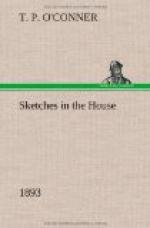[Sidenote: Green Street Court-House.]
Mr. Carson, doubtless, has “autres fonctions” than that of Jack Ketch—who has always been so efficient and constant an instrument of Government in Ireland—but I am never able to regard one part of the official machinery by which wronged nations are held down as very different from the other. Above all, I am unable to make much distinction between the final agent in the gaol and those other actors who play with loaded dice the bloody game in the criminal court with the partisan judge and the packed jury. Doubtless, happy reader, you have never been in a place called Green Street Court-House, in Dublin. If you ever go to the Irish capital, pay that spot a visit. It will compensate you—especially if you can get some cicerone who will tell you some of the associations that cling around the spot. It is in a back street—narrow, squalid, filthy—surrounded by all those signs of crumbling decay which speak more loudly to the visitor to Dublin of the decay and destruction of a nation than fieriest orator or solidest history. And in no part of Dublin have Death’s effacing fingers worked with such destructiveness as in all the streets that surround the Green Street Court-House. Palatial mansions are windowless, grimy, hideous—with all the ghastly surroundings of tenement homes of the very poor.
It is in Green Street Court-House that the political offenders in Ireland are tried. Within its narrow and grimy walls I saw many a gallant Irishman, when I was a young reporter, pass through a foregone and prearranged trial to torture, agony, madness, premature death. I can only think of it as of a shambles, or, perhaps, to put it more strongly, but more accurately, as I think of that wooden framework in which I saw the murderer, Henry Wainwright, hanged by the neck one foggy morning years ago, a gallows. The jury was packed, and the judges on the bench were as much a part of the machinery of prosecution as the Counsel for the Crown. The whole thing was a ghastly farce—as ghastly as the private enquiries that intervene between the Russian rebel and the hunger, and solitude, and death of the fortress of St. Peter and St. Paul, or the march to Siberia.




